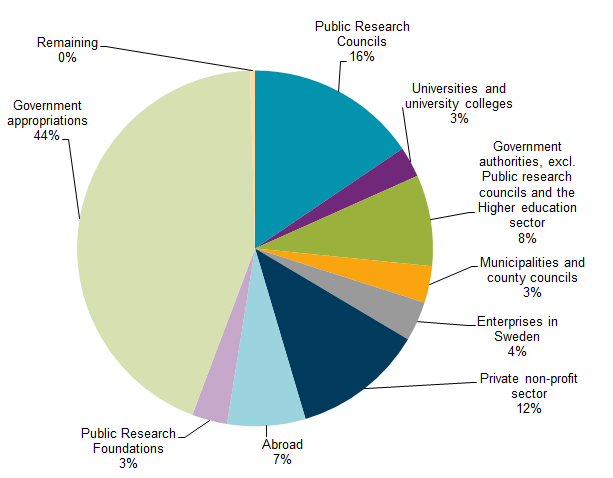Preliminary figures on R&D in Sweden 2017:
Expenditure on research and development increased
Statistical news from Statistics Sweden 2018-07-13 9.30
Expenditure on research and development (R&D) in Sweden increased between 2015 and 2017 in fixed prices, according to preliminary figures. Government sector expenditure accounted for an increase of 16 percent, the largest relative increase among all sectors. However, the business enterprise sector accounted for the largest absolute increase, with SEK 8.8 billion in increased R&D expenditures.
R&D expenditures increased in all sectors included in this report. At this stage of the survey, the values for the private non-profit sector are too uncertain and figures for the sector are thus not included in the report. Results indicate that the trend of increasing investments in R&D in recent years is continuing.
| 2015 | 2017 | ||||
|---|---|---|---|---|---|
| Value | ±CI[1] | Value | ±CI[1] | ||
| Business enterprise sector | 99 112 | 1 935 | 107 919 | 2 198 | |
| Higher education sector | 37 985 | ‑ | 39 182 | ‑ | |
| Government sector | 4 860 | ‑ | 5 633 | ‑ | |
| Central government | 2 487 | ‑ | 2 701 | ‑ | |
| Countys (excluding ALF resources) | 2 064 | ‑ | 2 534 | ‑ | |
| Municipaliteies and R&D-units | 309 | ‑ | 398 | ‑ | |
| Private, non-profit sector | 263 | 164 | ‑ | ‑ | |
[1] 95 percent confidence interval
In the business enterprise sector, R&D expenditures and the number of R&D employees have both increased between 2015 and 2017. Due to changes in the survey population, it is difficult to draw any clear conclusions concerning changes between industries.
Among Swedish higher education institutions, different types of players finance R&D activities. The figure below shows the distribution of operating costs related to R&D activities by sources of funding. Operating costs, which are estimated using the institutions’ income, amounted to SEK 36.8 million in 2017. This distribution has largely remained unchanged since 2015. Note that to avoid double counting, ALF funds, state-funded compensation to cover additional costs for clinical research and education, are included in this sector and are excluded from the government sector.

Investments in R&D in the higher education sector amounted to SEK 2.3 billion in 2017, an increase of SEK 187 million since 2015.
R&D expenditure in the government sector amounted to SEK 5.6 billion in 2017. Since the previous survey, R&D expenditure has increased by SEK 773 million. County councils’ expenditure has increased by 23 percent, which is the highest share in the sector.
Results were based on preliminary figures from Statistics Sweden’s R&D surveys. This means that estimations are uncertain and may be revised. Moreover, changes in the definition of R&D may affect the results.
Definitions and explanations
R&D
Research and experimental development (R&D) comprise creative and systematic work undertaken in order to increase the stock of knowledge – including knowledge of human kind, culture and society – and to devise new applications of available knowledge. The activity must be novel, creative, uncertain, systematic, and transferable and/or reproducible.
Intramural R&D
Activities carried out in Sweden by the organisation’s own personnel, or by consultants in an R&D project led by the organisation, where the organisation’s personnel have worked together with consultants. Intramural R&D includes R&D assigned by others.
Feel free to use the facts from this statistical news but remember to state Source: Statistics Sweden.
